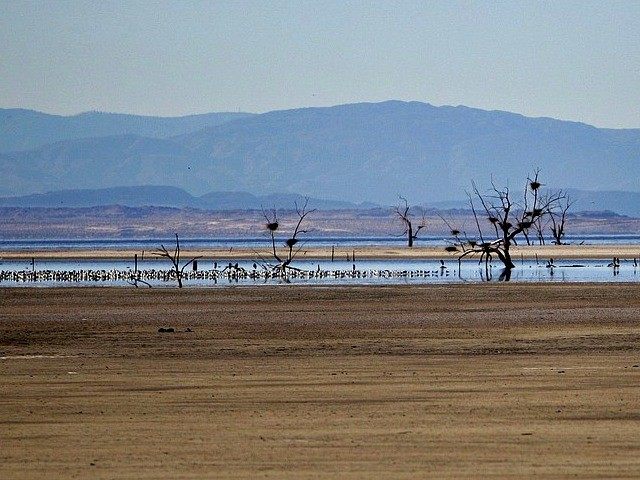In the 1970’s the communities on the perimeter of the Salton Sea enjoyed tremendous allure as recreational adventure spots for families as well as a glamorous get-away for the rich and famous. But according to one former Bombay Beach resident on the eastern shore: “It’s not like it used to be.”
Wendall Southworth, 86, who owned a vacation home and spent summers dirt biking with the family. “We’d stop in the Ski Inn and have a beer. It was crowded,” he said. “There used to be five bars in this little town. Now it’s just the Ski Inn and the American Legion.”
Now The Press Enterprise reports that the resorts and celebrities are gone, wildlife has diminished leaving a scarce collection of pelicans alone on the glassy water. Cracked asphalt blights the coastline where abandoned construction projects overlook the increasingly dried-up shoreline.
What was once referred to as the American Riviera by tourists, is now referred to as an ecological disaster by conservationists.
What happened?
First, municipal wastewater and runoff from thousands of acres of agricultural fields flow into the 350 square mile reservoir. Moreover, less inflow from natural water sources have shrunk the lake as a result of a farm-to-city water transfer approved in 2003.
By 2017 the lake will be receiving less than half the water it receives now which will dry up the lake damaging the fish and wildlife habitat. The area looks to lose more than 400 species of birds.
On top of that, the reduced water levels have boosted the salinity percentage rendering the Salton Sea about 50 percent saltier than the ocean. Ultimately, according to the Enterprise, increased salinity will have a negative effect on the 400 million tilapia, living in the 33 mile long lake. Tilapia is the last surviving sport fish in the Sea.
In addition, fertilizers, pesticides and selenium resting at the bottom of the lake stirred by the region’s regular wind storms may cause health problems for many already suffering from living in an area conducive to allergies.
All of this is accented by a severe rotten egg stench that erupts periodically from winds stirring up decaying matter at the bottom of the lake.
The consensus among experts is that small interim projects can be implemented to restore the area and bring it back close to where it once was. According to the Enterprise below are a few of the solutions:
- The Torres Martinez Desert Cahuilla Indians used a federal grant to create 85 acres of shallow wetlands on their land at the north end of the Sea.
- On the southern end, at Red Hill Bay, 600 acres of dry lakebed will be turned into shallow bird habitat. The $25 million project, which calls for construction of berms to impound water, is meant to serve as a model for future developments. Construction on the joint project between the U.S. Fish and Wildlife Service and Imperial Irrigation District is scheduled to begin next year.
- The state is planning a 640-acre species habitat conservation project on the southern end of the lake to create shallow ponds for birds to feed, rest and breed.
- The Imperial Irrigation District has a Water Marine Habitat Pilot Project on the southeast end of the lake that will use an existing desalination plant to treat lake water for a quarter-acre shallow pond on exposed playa.
- The Imperial Irrigation District and Imperial County also are working on a project to combine habitat with geothermal and other renewable energy projects.

COMMENTS
Please let us know if you're having issues with commenting.